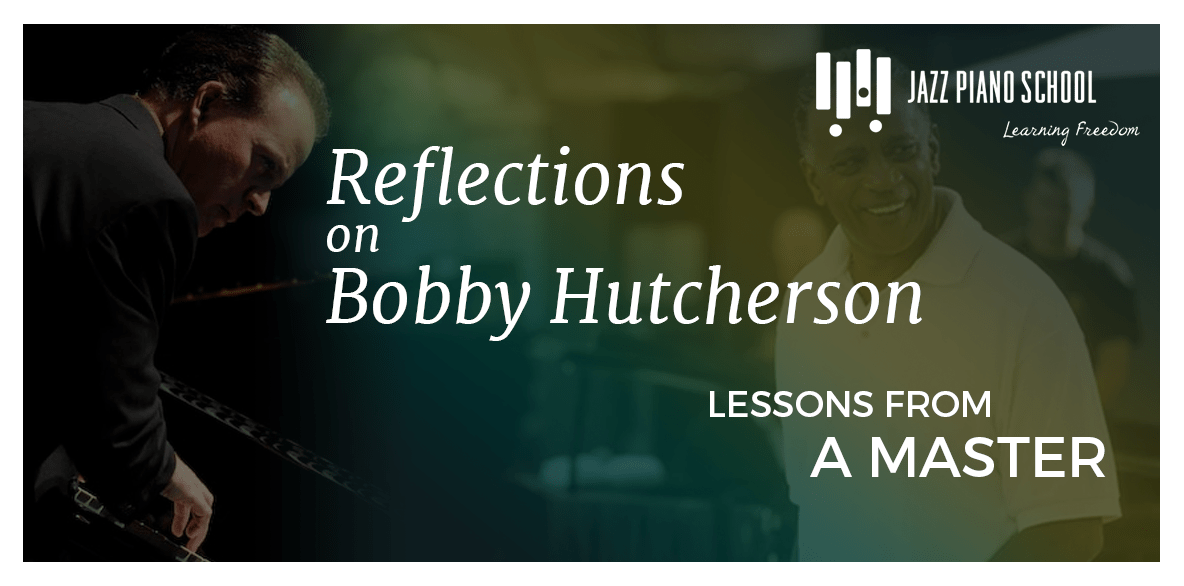
I had the distinct honor and privilege of being the primary pianist to jazz vibraphonist Bobby Hutcherson from 2006 until his passing on August 15th. Although I enjoyed many performances with him on the Western Coast of United States, Bobby would often take me to the East Coast; Boston, New York, Washington D.C., and often overseas- to Paris, London, Italy, Poland, and other places around the world. It was during these times and performances that I learned so much from Bobby. I thought that this would be the best time to share some of the lessons that I have learned from him with the audience that might like to know him better.
“That’s the chord, but that’s not the sound…”
I remember my first rehearsal with Bobby, I sat down at a keyboard in the corner of his
living room at his house in Montara, CA. It was just the two of us for a while, and we sat down to play a tune called “Ode to Angela.” As I read through the chart, he stopped me almost immediately. “That’s not the sound.” I looked at the chord on the chart, and was playing voicing that I thought was appropriate for the chord, given the tune and the style. He said “yeah, that’s the chord, but that’s not the sound.” He went around my back and reached his arms over me. He laid his fingers down on some tones for an A-flat major seven chord resolving to a B-flat major seventh chord. I understood what he was playing, but they were completely different notes than I would not have chosen. “That’s the sound for this song”, he said. That got me thinking about the difference between chords, and voicings, and sounds. Chords are the harmonic progression for a tune (“what are the chords…?”). Voicings are specific arrangements of the tones that musicians use for the chords, often coming from some sort of historical perspective. But “sounds” have a character, they provoke and evoke, they set the stage for upcoming events. They provide more meaning and context for the improviser. From then on I understood that each tune that Bobby played was in a set for a particular reason, and each tune had a particular “sound” he was going for, not just a series of chords in a progression.
“The call” I looked down at my cell phone and saw an incoming call from the Hutcherson’s. Of course I expected this call. It was the day before a performance, somewhere. Generally, we hadn’t played for a while, sometimes it had been months since we had played. But I always knew that this call would be coming. Bobby would always call the day before a performance. But like most musicians who would call and say, “hey, we got a gig tomorrow at 8:30, see you there.”, Bobby’s call would always start with; “How are you? How’s the family? How is Andrew? How old is he now? How’s your health? How is your mother doing? How is school?” This would go on for 10 or 15 minutes, and finally at the end of the conversation he would say; “Well… you know we got a thing tomorrow…”, and I would always say; “Yeah, I know Bobby, thanks for the reminder.” This was the way Bobby would always set up his musicians with a familial feeling. We were all getting together to celebrate and play music together. It wasn’t just a gig. We were all friends, getting together to have a conversation. And he was looking forward to that event.
“Set lists”
Bobby often liked the band to arrive at the venue early, sometimes several hours early. Driving a few hours, and having a sound check a few hours early, I always knew that an event with Bobby would pretty much mean “the day.” But he would always want us there early, to make sure that there would be no mishaps. Even before the first set, he would like us there pretty early. Anytime I walked into the green room, there was Bobby, sitting, staring, generally at a blank piece of paper. I could see that he was combing through his mind for what the tunes of our first set would be. The first tune had to be just right; it had to introduce all the members of the band, it had to introduce the feeling that he wanted the audience to have when they first experienced the presentation. After he selected that first tune, he would start working on the second tune in his mind. It had to be different than the first; different soloists, different order, it had to come down ever so slightly, but not come down so much that the audience felt let down. The third tune is where we would start going deeper into the music, either in terms of ensemble interplay, or a reference to the history of his compositions, or the jazz genre in general. The fourth tune was usually a ballad, but often very short; a presentation of the melody and maybe a half chorus of improvisation. A nice pallet cleanser for the audience, or just a change of floral arrangement in the middle of the dinner table. This would continue, but he would have to make sure that the last tune wrapped everything together, leaving generally on an energetic note, and often a thought-provoking one. And introductions and endings to tunes were often predetermined, as if we were a chamber music ensemble; fixed, yet flexible. When we went out to play the set, Bobby often said nothing between tunes. He would only click his sticks together to give us a tempo. Often times, however, he would take quite an extensive silent interval between tunes, when he knew the audience needed to settle down, relax, regroup, or just enjoy a quiet moment between selections. Sometimes he might say a few words so that the audience knew that we knew they were there, and that we appreciated their ears. Nevertheless, often after the second or third tune, the band had interpreted his selections differently than he had anticipated, and he would start changing the set. Of course we knew this would happen, because it happened very frequently. So, Bobby may have whispered an alternate tune to us, but he often would just click his sticks, and we knew from the change in tempo from the sticks that he had picked a different tune. After playing together in an ensemble for so long, we knew that he might make a change of repertoire, and we knew when it would come, and we knew what the alternate tune would be, without him even saying anything. This really gets to the essence, validity, and importance of having an ensemble that stays together for long periods of time. Collectively developed intuition.
“Stories”
An important and very pleasurable perk to being in Bobby’s band for so long was all of the stories that he would tell. Often backstage, Bobby would start into a story, and his wife, Rosemary, who had had heard the stories so many times, would say “Oh boy here it comes”, and would leave the room! I thought that was so fun to see the relationship between Bobby and Rosemary. All of those stories…being the son of a successful brick mason in Los Angeles, his sister the actress that dated Eric Dolphy for a short time…he drove a taxi in New York through all of his Blue Note records. Unbelievable. The stories about rehearsing with Eric Dolphy in Los Angeles, and how dedicated, forgiving, and understanding Dolphy was about people’s perception of his music. Inspiring. The stories of learning how to play the music as a teenager, spinning records with Terry Trotter. The stories of being on the road with Herbie Hancock and how eloquently he would dress, and how the band will try to keep up with Herbie’s fashion sense. Going through airports with Billy Higgins. Locked in the basement of a jazz club all night with Woody Shaw, terrified of the racket emanating from a radiator. Losing is cabaret card in the late 60’s, but being saved by Harold land. Being told by Ornette Coleman that he would shave his beard when he found his sound. Then finally seeing Ornette without a beard. Then months later, Ornette was at the Five-Spot. All of these stories lent context and personification to the text books and articles I had been reading for so long. They really turned history of jazz into a personal and living account for me, one that I could forever relate to my students.
“Music is not the image, it’s the reflection.”
Whenever Bobby was asked by an interviewer to offer some sage advice, or a quick quote, he would often utter this phrase. It’s a phrase that instantly makes sense, but is thought-provoking nevertheless. Jazz musicians learn our chords, our scales, forms, classic solos, learn how to play as a group, listen to recordings, interact…and everything else that we do that we’re told from our first experiences with this music. What he was trying to say is that all of these things are just a reflection of the soul of the person. People do not hear chords, scales, enclosures, tritone subs. They hear feelings, stories, life. They hear sounds being born, poetry, colors. They hear the reflections of everything that we’ve experienced, and even reflections of things that the audience themselves have experienced. This is why it is so important for students to learn the value of finding their own sound, having life experiences, writing about themselves, finding themselves. Often musicians will rehearse at home, and have a performance, and then talk about it later in a positive or a negative sense, as if it was a “thing.” The audience has more of a perspective that the performance is a reflection of who and what the musicians are inside, in a much deeper sense. It behooves the musicians to understand this and understand the perception that an audience has of the musicians and of their performances.
“The educator”
By the time I started playing with Bobby as his regular pianist, I had already been in higher education for 11 years. I thought that my relationship with Bobby could potentially help to introduce him to the world of education. I wanted to invite him to come to the schools where I taught to talk, and even play, with the students. I quickly learned that this style of education was not Bobby’s preference. I did not want to belabor the point of trying to bring him out to one of my schools for a clinic. I did not want to be a nuisance to him or to Rosemary. Nevertheless, all of the stories, behaviors, actions, and everything else that Bobby shared was education enough for me. Those I could convey to my students, either in a very direct way, or in a secondary way. Reflecting some of his behavior in my own teaching and style of delivery. There were a small number of occasions where Bobby was open enough to host a visit from my students. In these cases, he would give very honest critiques and evaluations of my students, and give short comments, usually of a subjective nature. He would often talk in analogies or parables. This also speaks to the nature of music not being an image, but a reflection. It is not a thing, but it is “as if,” or “is like” this other thing. So when Bobby started talking about the stars, or bells, or boxers, cowboys, football… you knew he was trying to get the student to hear the music as it should be perceived, not as a collection of musical concepts that they had practiced. Bobby would almost never talk about his songs in the technical sense. He would never talk about what scale to play (although I remember him once talking about a “refrigerator chord!”). He would show us the sounds of the song, and then allowed us to explore those sounds, but taught us to stay within the framework of the sounds, or within the emotional experience that he wanted the
band and the audience to have through the composition.
“Final visit”
I got the chance to see Bobby for the last time in the middle of July. His son had told me that he didn’t have long. I knew that I needed to tell Bobby how important he was to me, and how important he had been to many musicians, and the jazz world in general. For that matter to anybody that had been blessed to have had the experience of just being around him. I asked him what message he would like me to share with my students and other educators. He could only manage a few words at that point, but they were; “Take it slow… Take it slow… Take it slow.” Learning music, sharing your music, a career in music, composition, building a solo, understanding yourself and other people…all takes time. It is not a race. There is no finish line. There is no destination really. We are all just here to experience, to share with each other, and to do the best that we can in life. Take your time and enjoy the experience of learning about music, sharing it with others, and living life.
For more information on Joe Gilman visit http://www.joegilman.com/


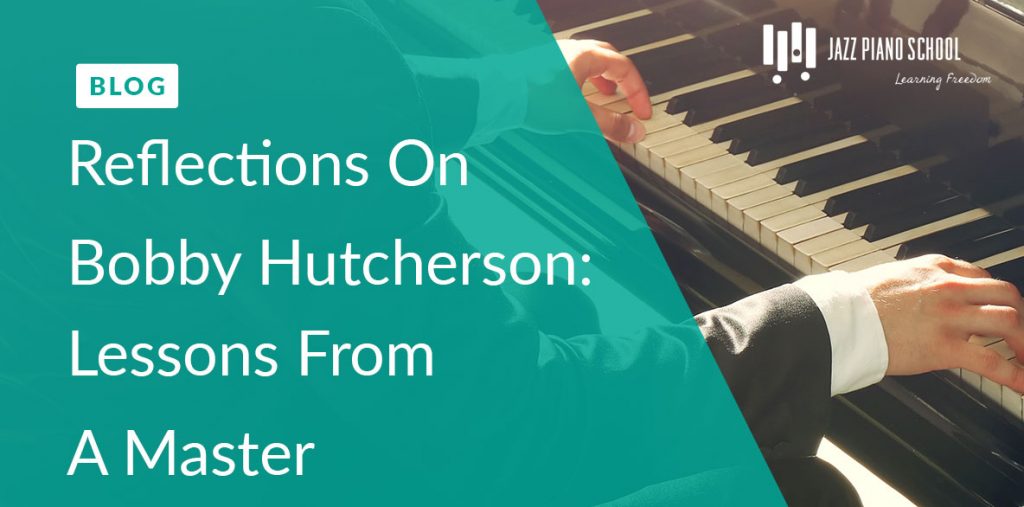


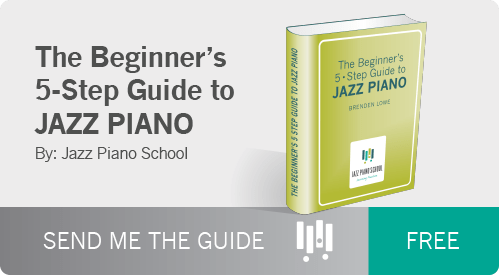
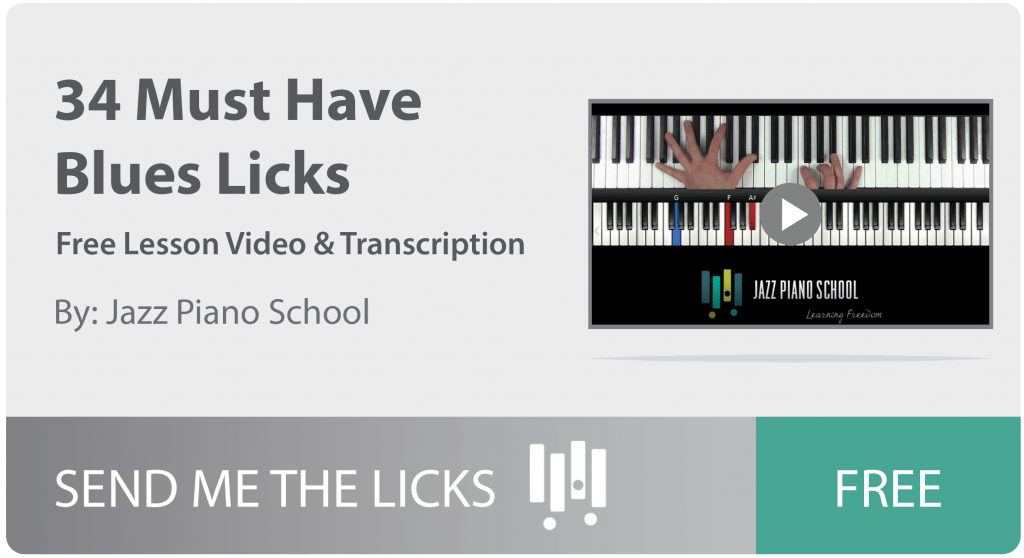




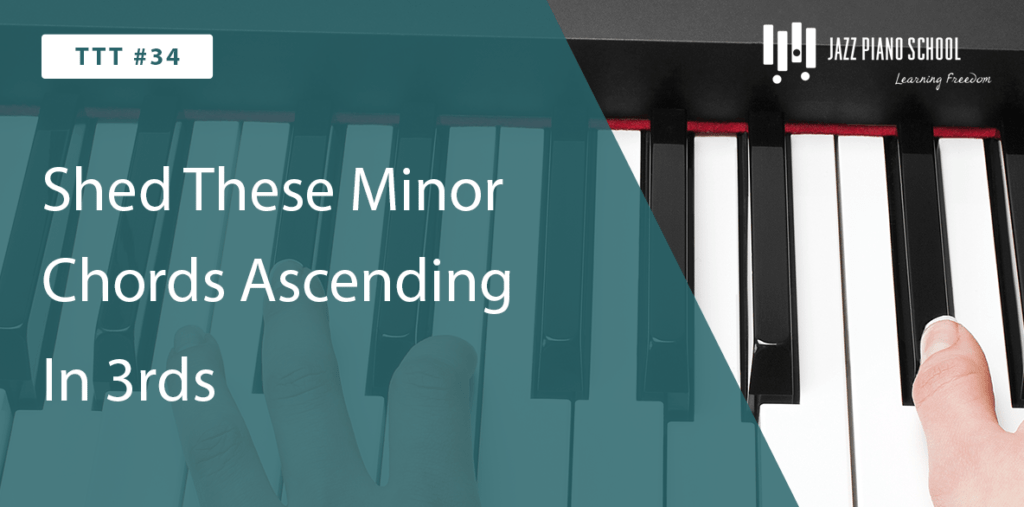
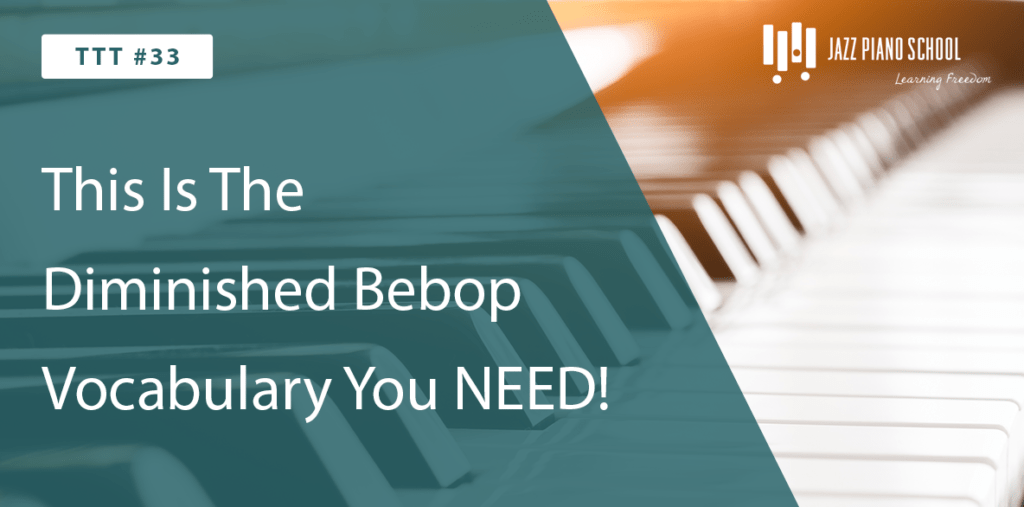


18 Responses
What a great article. I really enjoyed reading this journey with Bobby…. I get it!
Wow that’s it!
Lovely article.
I used to be a big fan of Bobby Hutcherson in the late 60’s/early 70’s then my music tastes changed and I never listened to him anymore.
A regret.
Yes, my friend ! Yes, …I believe you are blessed, and Bobby was truly blessed to find you. You both, with the other musicians, made very real, very important, very needed and very beautiful music together. “Take it slow” …such an amazing suggestion, and learning tool for living ones life with deep, unhurried, reflection and perception, and to always strive for beauty. Take it slow, I love it ! Thank you Joe.
Beautiful Joe.I hope we get to play sometime.
Words of wisdom and beauty seasoned with reflection and care.
Joe, Your mother as well as all the rest of your family are so so proud of you and what you have accomplished. What a beautiful tribute you professed to your good friend and mentor.
Thank you Joe! Such a beautiful recollection.
Thank you Joe!
Thank you Joe! I will remember the many gems of wisdom you’ve shared. “Take it slow.”
Thank you Joe! I wish my English was better to express my deep emotion, my enchantment and gratitude. Your text sounded like “sounds” on a perfect set list.
Thanks again for sharing this blessing to us students that are trying hard to accomplish our goals,,, blessings to all his family, friends and all JPS staff and students..
Thank you so much for this Joe! So beautiful and so much truth- Bobby was truly a master of the highest order.
Sorry Joe! That was me….
Wow! Thank you for sharing your experience and finding such a direct way to express what is often so difficult to put into words. Clearly you appreciate how rare it is for musicians (and everyone else) to experience this kind of language and thinking. more please!
This is beautiful. Thank you.
Thanks for sharing this… great insights.
This is a fantastic reflection of, for me, one of the greats of jazz and the greatest vibist ever. I have been listening to recordings of Bobby since the early 70s after being inspired by Milt to take up vibes. I love Bobby’s compositions and play Little B’s Poem, Highway One and Montaro. I wish I had heard him play live but I live in Perth, Western Australia and have only made it to the US twice. Anyway I have probably most of his recordings as leader and many as a sideman.
I love the you tube clip of the concert of Bobby with Joe Gilman in Europe. Joe – you were a great accompanist for Bobby and part of a pantheon of pianists to perform and record w. Bobby that includes Herbie, McCoy, Chick, Kenny B, Tommy F, Mulgrew, Geri and George Cables.
Bobby’s music will live forever.